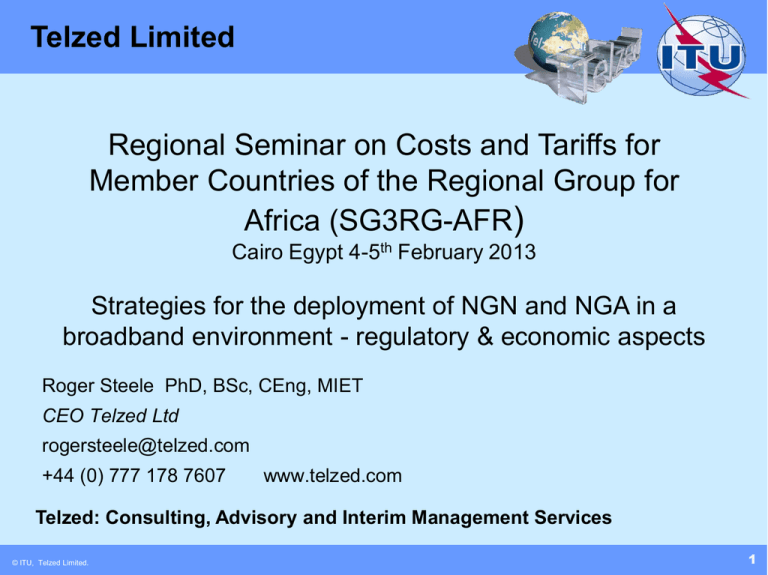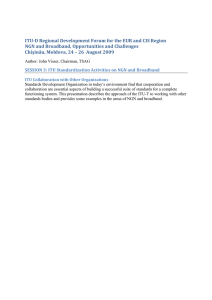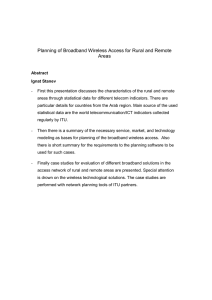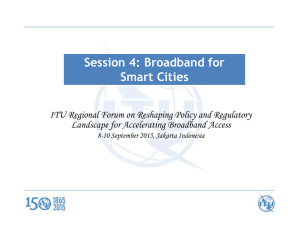) Telzed Limited Regional Seminar on Costs and Tariffs for
advertisement

Telzed Limited Regional Seminar on Costs and Tariffs for Member Countries of the Regional Group for Africa (SG3RG-AFR) Cairo Egypt 4-5th February 2013 Strategies for the deployment of NGN and NGA in a broadband environment - regulatory & economic aspects Roger Steele PhD, BSc, CEng, MIET CEO Telzed Ltd rogersteele@telzed.com +44 (0) 777 178 7607 www.telzed.com Telzed: Consulting, Advisory and Interim Management Services © Telzed ITU, Telzed Limited. Limited. 1 Agenda Introduction to the author Background to the study What are NGNs and NGAs – broadband definitions Economics – why broadband is required The critical questions A top down approach to strategy This paper is a discussion/ideas document. Any ideas expressed need not represent views of Telzed Limited or any client. No liability is accepted for any actions taken based on the report. No warranty is given for the accuracy The ITU paper’s key messages are further developed in Session 4, which looks at stimulating demand, and getting solutions that work © Telzed ©ITU, Telzed Limited. Limited 2 Telzed & Roger Steele: 30 years of international experience in telecommunications Cost and profit model analysis Bottom up, top down, FAC, LRIC, ABC, fixed/mobile/access networks, NGN/NGA, for commercial & regulatory management Regulatory accounting Accounts production, review/approvals, current cost accounting (CCA), cost model reviews Regulatory policy and economics Tariff approvals/price controls, regulatory submissions, regulatory strategy, wholesale product analysis, consultations, benchmarks Financial & business analysis Price setting & price controls, due diligence, license applications, strategy support, MVNOs, SIM boxes Complex problems Technical/financial analysis, legal arbitrations, expert witness, market demand modelling, network outsourcing & service procurement for corporates © Telzed ©ITU, Telzed Limited. Limited Telzed provides a combination of business, economic, regulatory, financial and technology skills. Roger has worked in Egypt, Sudan, Jordan, Palestine, UAE, Bahrain, Oman, Qatar, South Africa, Mexico, Hong Kong, Korea, Singapore, the Kingdom of Saudi Arabia, and extensively across Europe 3 Background to the study The ITU has developed a series of papers and seminars related to regulation, pricing, funding and policy approaches to help countries develop their telecoms services A major focus in recent years has been on Next Generation Networks – what are the challenges and benefits from the new telecoms technologies To assist with this programme, a paper that looks at the higher levels strategic issues, the economics and fundamental issues was sponsored This broadband strategy paper should be considered alongside other ITU studies The study’s purpose is to provide insights to help develop national strategies and regulatory approaches towards broadband that will benefit the telecoms industry, consumers and all businesses that make use of telecoms services http://www.itu.int/en/ITU-D/Regulatory-Market/Pages/Studies.aspx Strategies for the deployment of NGN and NGA in a broadband environment – regulatory and economic aspects © Telzed ©ITU, Telzed Limited. Limited 4 Questions to answer What are NGNs and NGAs? What are the benefits? Who needs to be involved? What are the issues to address? What needs to be done? How should policy makers act? The link of government and private enterprise What approaches in developing economies? How to keep costs low? Some of the answers will be developed in the later session We will not attempt to cover how to obtain the funding © Telzed ©ITU, Telzed Limited. Limited 5 Next generation networks Voice, data, TV etc. service platforms 4G/LTE wireless access Local loop access interconnection Copper final links Fibre Cabinet Fibre access Shared packetbased core Other service providers Network interconnection Internet Copper access 2G and 3G voice and data © Telzed ©ITU, Telzed Limited. Limited Internet based services 6 What is an NGN? A single packet based network what carry multiple services. The service provision is not part of the network’s internal systems. No need for multiple networks Access: access technology (fibre, copper or wireless and combinations) deployed in the “local loop.” Typically characterised by higher bandwidth and greater symmetry in speed than purely copper-wire access Core: core network is IP based and is characterised by replacement of legacy transmission and switching equipment with IP technology in the core, or backbone network. Involves changing telephony switches and installing routers and VoIP gateways. Services: new structures in a NGN environment. Often not fundamentally new services but are now much faster/better and not “part of the network” because a shared network now delivers all of the services © Telzed ©ITU, Telzed Limited. Limited 7 What is broadband? Access to services at multi-megabit/s speeds Can be over fixed lines or over mobile networks. Also fixed wireless access (but this is less common) Up to ~10Mbits/s using copper technology or 3G mobile >> 10Mbit/s using fibre to the premises or fibre to the cabinet plus copper wires for the “last link” to the premises. Might use wireless for the last link to customer. Cable TV networks also use fibre, plus coaxial copper > 10Mbit/s using LTE (4G) mobile technology Superfast broadband: >30Mbit/s. Mostly fibre all the way. 1Gbit/s is possible. Broadband enables the services: Internet access, TV, voice © Telzed ©ITU, Telzed Limited. Limited 8 Benefits of broadband: you can do a lot with it! Internet access! TV YouTube Video on demand Facebook Additional cost of voice is low Access to information and government services Nice things to have and fun to use But are consumers and the national economy really any better off? These services are possible without NGN, so why bother? © Telzed ©ITU, Telzed Limited. Limited 9 National wealth is related to Internet and Broadband usage 140,000 Internet penetration GDP per capita ($US) 120,000 Broadband penetration 100,000 80,000 60,000 40,000 20,000 0 20 40 60 Percentage of population More broadband is good © Telzed ©ITU, Telzed Limited. Limited 80 100 Source: ITU and World Bank data & Telzed analysis 10 Broadband and the economy. It should be taken as a basic assumption that broadband helps the country Similar to basic telephony, having the service helps the economy Note how even having a basic phone enabled trade and business Broadband has similar effects The correlation of GDP with broadband is causally related. Contrast: higher GDP is probably related to numbers of Ferraris, but more Ferraris do not help the GDP! Natural logic. Broadband access: increases communications and trade; reduces travel; allows home/remote working; creates more efficient ways of working etc. and all increase the national economy Some studies suggest a synergy. The % increase in GDP with a percentage increase in broadband, increases with penetration © Telzed ©ITU, Telzed Limited. Limited 11 Benefits of broadband come from how it is used Trade – national and international Agriculture – information education advice Avoided travel. Make use of limited resources Healthcare – access to scare resource end experts Education. Interactive and remote access Huge range of government services Local language services Tax collection licences, payments, advice Entertainment Relevant to emerging and developed economies The end users benefit. The service suppliers benefit. The network providers benefit. The national economy benefits. The government then benefits (general taxes) © Telzed ©ITU, Telzed Limited. Limited 12 The economics of broadband Speed Copperfibre Wireless – high density Copper upgrade Fibre to the premises Wireless – low density Wireless – very high density New copper build No point in building new copper networks Wireless options have role to play in all countries (high & low GDP, high and low population density) Wireless is very important where cost matters and there is little copper infrastructure to build on Cost per subscriber © Telzed ©ITU, Telzed Limited. Limited 13 Investment, regulatory decisions and policies should centre on the key building blocks IP routers and broadband service platforms Internet Exchange Copper/fibre/radio access Wholesale access to customer by ISP National internet services & content: hosted in IT centres IP transit – national and international links National ISP interconnection Other national internet service providers Internet – rest of the world All of the global Internet services Internet access is the most important service Even in emerging economies “almost everyone” has a mobile handset © Telzed ©ITU, Telzed Limited. Limited 14 Access economics and regulation are linked Big investment is required Not sensible to have two cables and two trenches to same street Inherent “bottleneck” – competitive supply is not feasible Lack of competition – requires regulation Spectrum is limited – only a few wireless networks are viable Duct/digging, cables, masts – infrastructure access may be required Access bit stream – network level access may be required High cost, long time for a return, even with shared networks – leads to government funding (even in EU, USA, Australia). Access is perhaps more like road/water/power infrastructure and competing services can be developed on top of this © Telzed ©ITU, Telzed Limited. Limited 15 Core network economics and regulation IP routers and broadband service platforms Usually core NGNS can be telco funded Several operators can be viable Internet Exchange National ISP interconnection Other national internet service providers Internet – rest of the world Need to ensure interworking and interconnection Must allow competing services to be supplied over the core network In large countries and to remote areas, the connectivity of the core may need external funding The “Road analogy.” Example: backbone networks are provided in South Africa by government and private enterprise Contrast to developed economies – often many capacity providers between cities (but they often cannot connect to the customer) © Telzed ©ITU, Telzed Limited. Limited 16 Alternative broadband service providers and content Let alternatives providers gain access to the bottleneck services (network access) Service-level competition (in contrast to access-network competition) is relatively easy to foster Internet Exchange National ISP interconnection National internet services & content: hosted in IT centres Other national internet service providers Need regulatory freedom in downstream markets and rights of access/interconnection May need some help with platforms – secure IT centres, exchange points. Possible funding or “seeding assistance” Content and services – the real consumer benefits are derived from these © Telzed ©ITU, Telzed Limited. Limited Internet – rest of the world 17 International connectivity is often a major factor Internet Exchange International Internet capacity is freely traded and competitive But often limited capacity in emerging and remote countries IP transit – national and international links Other national internet service providers Internet – rest of the world All of the global internet services International cables are required. May need funding and incentives to get the investment made IP transit is very cheap in developed economies and keyglobal centres Forms a significant portion of the cost of Internet services in emerging/smaller economies There are ways to reduce the impact © Telzed ©ITU, Telzed Limited. Limited 18 The issues need a joined-up approach Policy makers Regulatory authorities Investors Service providers Broadband and broadband benefits do not just happen. Most countries have linked programmes and policies. Look at Korea, EU, Australia Unlike most telecoms movements in last 20 years, there has been increased government intervention and funding, in broadband Need a policy and programme that links all areas. A vision for the country. Might link it to neighbours © Telzed ©ITU, Telzed Limited. Limited 19 Policy issues Spectrum Services Frameworks Education and content Spectrum – especially important in emerging economies. Mobile and wireless broadband also important in developed countries. Spectrum policy is linked to fixed networks Services. From network and infrastructure to voice and internet access. Maximise freedom to act and minimise regulation. Minimise restrictions Frameworks. Consumer rights, confidentiality, copyright, security Education and content. Can supply “normal” education and information to everyone. Also need ICT education to make use of IT/broadband. Also need more on how to develop services and content © Telzed ©ITU, Telzed Limited. Limited 20 Key components when developing a policy Top level policy Government TV & radio Legal frameworks Spectrum Regulation Services & content Education Licenses Network Funding Private Enterprise Consumers and national economy All areas are inter-related Need a top down, fully comprehensive approach © Telzed Limited. 21 Regulation plays a central role National policy National legal framework Regulatory strategy Regulatory controls Funding NGN and broadband approaches Regulation helps to make the wider policies work. Regulation has its own plans and frameworks to achieve the national aims Regulation is not directly concerned with funding, but with regulating what is spent (built) and encouraging funding With broadband and NGN, new ways of thinking and acting are needed But the fundamental principles of regulation remain © Telzed ©ITU, Telzed Limited. Limited 22 NGN and broadband regulation Competition, easy market entry Do not regulate unless you have to Some areas do need regulation Retail and wholesale markets – what are they? Markets Define what to regulate Price controls Mainly in wholesale markets Cross subsidies. Dangers from, plus use of, to assist other market segments Interconnect and access How should services and service providers interconnect The digital divide Some areas/customers cannot be addressed economically © Telzed ©ITU, Telzed Limited. Limited Allow access at what levels Big issue in all countries and critical for NGN regulation 23 NGN regulation requires some new thinking Mobile internet Service level interworking Broadband access by ISPs/altnets Content regulation? Shared networks but reduced competition Legacy copper versus fibre Bigger focus on mobile in emerging economies. Some are almost mobile-only Some backtracking is seen on some past regulation – increased intervention in some cases A “Big issue” with NGN and fibre, is centred on copper legacy. See EU – may not be valid in less developed countries © Telzed ©ITU, Telzed Limited. Limited 24 Key messages NGNs and broadband services benefit everyone A comprehensive approach is required covering many areas. Do not think “just telecom,” but consider all parts of the economy and all industries that benefit Have a policy and a plan. This has the aims and targets, but more importantly it must define how to get there and what needs to be done Emerging economies may need more intervention and external funding than developed markets. Almost all countries need some intervention Study the issues and learn from the mistakes and successes of others Be far reaching – think 100Mbit/s or 1Gbit/s, not 1-2Mbit/s even if most have nothing today © Telzed ©ITU, Telzed Limited. Limited 25 Questions and enquiries always welcome Roger Steele +44 (0) 777 178 7607 www.telzed.com © Telzed ©ITU, Telzed Limited. Limited 26 27 © Telzed Limited. 27


